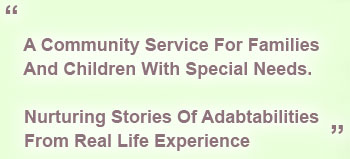Self-help Steps in Problem Solving
Family-Community Self-help Education
 |
|
- Introduction
- A Guide to Solution-focused Steps
- Step 1: Reflecting on Getting Ready
- Step 2: Ready-Set-Go
- Step 3: Review the Seven Clinical Problem Modules
- Step 4: World of the Child
- Step 5: Consulting and Conferencing: Multiple Systems of Care
- Step 6: Collaborative Core Teaming
Welcome to the ABLE Website. It is intended as a web-based service and learning site for not only parents, but for all care-giving disciplines and is concerned with the gathering of helpers to meet the challenges of individual children and youth with special needs when, despite all other efforts, expected progress is not being reached, or regression is seen, and the caretakers involved are beginning to lose hope.
This site offers specific answers to basic questions, but also offers a more detailed and complex set of guidelines and tools used in our practices and how they can be implemented by families and community agencies. Specific topics are listed as follows and on the homepage menu. What follows after the list are steps to learn our approach to working with the special needs population.
A Guide to Solution-focused Steps
Imagine some Russian dolls nesting within each another. Such an image could be viewed as a metaphor for combining things that work. Now let’s apply the metaphor:
We provide self-help steps for groups of two or more in starting on a journey toward understanding, healing and change. One option is to start out by going through the following steps sequentially. Another option is to go directly to the preferred step or selective topic, or go back to fast track for web use.
In step 3, the Seven Clinical Problem Modules deal with complex conditions and evolve along a developmental continuum which seem to combine many expression symptoms such as disruptive behaviors, cycling, anxiety, poor information processing and relationship-based challenges, and make up a group of children needing multi-modal wraparound services incorporating the idealized “village” concept. These severely functionally-impaired high risk children need to be attended to immediately.
Begin here for children with easier or more difficult problems.
| Step # | Topic | Description |
| 1 | Reflecting on Getting Ready | A short introduction offers methods to help manage high-risk and complicated children. |
2 |
Ready-Set-Go |
Begin with what’s working, then step back in reflection. Look for assets, competencies, interests and desires and other positive things! Now step forward in conversation with a support person. |
The next steps are for more complex problems with greater needs.
| Step # | Topic | Description |
| 3 | Review the Seven Clinical Problem Modules | Included here is a typical array of children’s behavioral struggles with behavioral screeners, websites and recommended books. |
4 |
World of the Child |
Promoted here are alternative views of problems and solutions in four contexts (Child, Family School and Cultural/Community). |
The finals steps are taking action together in the problem-solving process.
| Step # | Topic | Description |
| 5 | Consulting and Conferencing: Multiple Systems of Care | “Meeting of the minds” provides a setting to try something different, in a step-by-step approach using resources, ideas, and possibilities. Here, everyone’s expertise can be valued and respected in an attempt to see the whole picture while taking action. |
| 6 | Collaborative Core Teaming |
When the challenges are quite large and complex, collaboration with the family is useful with an on going set of meetings. Groups share ownership, responsibility, and success of positive outcomes. |
_______________________________________________________








Social Networks
Follow Us